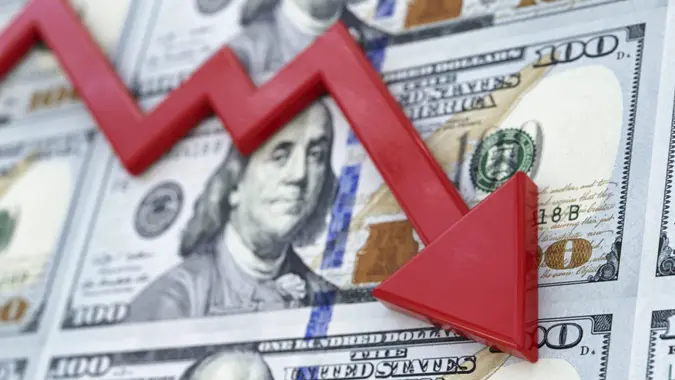A Risk in Today’s Economy That No One Is Talking About, According to Jaspreet Singh

Commitment to Our Readers
GOBankingRates' editorial team is committed to bringing you unbiased reviews and information. We use data-driven methodologies to evaluate financial products and services - our reviews and ratings are not influenced by advertisers. You can read more about our editorial guidelines and our products and services review methodology.

20 Years
Helping You Live Richer

Reviewed
by Experts

Trusted by
Millions of Readers
The American economy is historically strong. However, entrepreneur Jaspreet Singh says there’s a risk hiding in plain sight that nobody is talking about.
Singh is host of the “The Minority Mindset Show” and operator of the popular Minority Mindset YouTube channel. A serial entrepreneur and licensed attorney, Singh uses his platform to spread financial education.
In a recent YouTube video, Singh outlined the glaring risk that he said nobody is talking about.
Also see what the Fed rate cuts could mean for your money.
The Fed Is Lowering Interest Rates
Despite strong economic indicators, the Federal Reserve has begun lowering interest rates. As Singh noted, this is unusual: “Normally, the Federal Reserve bank cuts interest rates as a way to stimulate the economy.”
Singh highlighted the following interest rate cuts from recent history.
- 2019-2020: Cut from 2.5% to 0%
- 2007-2008: Cut from 5.25% to 0.25%
- 2000-2001: Cut from 6.5% to 1%
Each of these rate cuts was done in response to a major economic downturn. In 2020, it was the COVID-19 pandemic. In 2008, it was the Great Recession, and in 2001, the bursting of the dot-com bubble.
“The margin that the Federal Reserve bank has had to cut interest rates has been getting slimmer and slimmer and slimmer,” Singh said. “And that means the Federal Reserve bank has to get more creative to stimulate the economy.”
How Does the Fed Stimulate the Economy in a Recession?
According to Singh, the Fed has signaled that it aims to further reduce interest rates over the next 18 months or so. While that’s good news for anyone thinking about buying a car or a house, Singh noted that it’s an unusual step that carries some risk should the economy go into recession.
“We know that recessions happen,” Singh said. “We’ve seen a recession pretty much every decade for the last century … So the question is, if we’re cutting interest rates now, when we’re already in a strong economy, what’s going to happen if we enter a weak economy? How will the Federal Reserve bank stimulate then?”
Singh speculated that there are several potential avenues the Fed could take, including money printing, negative interest rates and more stimulus in the form of quantitative easing.
According to CMC Markets, quantitative easing in the process in which a central bank purchases government securities in order to stimulate the economy. Central banks usually look to other methods of stimulating the economy when interest rates are high; however, quantitative easing is an option when interest rates are already low.
Should the Fed choose this path, Singh explained, there’s a hidden risk that nobody is talking about.
What Is the Hidden Tax?
In the video, Singh used a broad hypothetical to describe the risks of using quantitative easing during a recession when interest rates are already low.
“If the government wanted to spend money, the way that they do that is by going to Congress and saying ‘Hey, we want to build a $1 trillion infrastructure package, and in order to finance this, we need to create this tax,'” he said. However, Singh noted, that’s not what has been happening. Instead, we’ve been seeing the federal government spend money it doesn’t have.
This is what’s known as “the hidden tax.” This money has to come from somewhere, and according to Singh, the Federal Reserve prints the money and lends it to the U.S. government.
So who pays the price?
Who Pays the Hidden Tax?
“The answer is … everybody pays the price,” Singh said. “When you print money … there’s a cost to that. And that cost is inflation.”
Inflation measures the rising costs of goods and services. It’s normal for prices to increase by 2% to 3% per year, but when inflation increases faster than that, it puts a heavier burden on consumers. On the flip side, when inflation happens, you spend more money at businesses, which often delivers disproportionate benefits to investors.
“The most expensive kind of money is, of course, free money because the person who pays the price is the person who doesn’t understand it,” Singh said. “So the average person ends up getting hurt even more.”
What Happens If a Recession Hits?
When the economy is slow, the Federal Reserve often cuts its interest rates to stimulate borrowing and put more money into the economy. However, what happens if a recession hits when rates are already low?
Singh said it’s likely that the Fed would print more money and invest more money in the economy in the form of quantitative easing. This has two hidden costs: inflation and an increased national debt, which may lead to tax increases later on.
We can’t control what the Fed does. Instead, Singh said you should pay down your credit card debt, set aside cash for an emergency fund and make sure you have some cash lying around to capitalize on any investment opportunities that arise.
More From GOBankingRates
- Nearly 1 in 3 Americans Hit by a Costly Holiday Scam, Norton Survey Shows -- How To Avoid This
- Here's What the Average Social Security Payment Will Be in Winter 2025
- How Middle-Class Earners Are Quietly Becoming Millionaires -- and How You Can, Too
- The Easiest Way to Score $250 for Things You Already Do
 Edited by
Edited by 

























